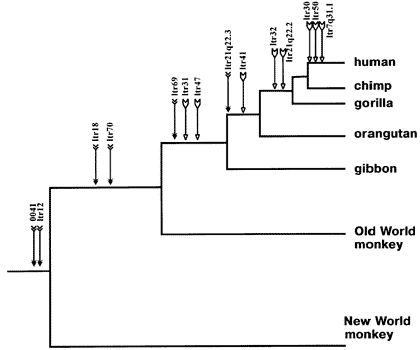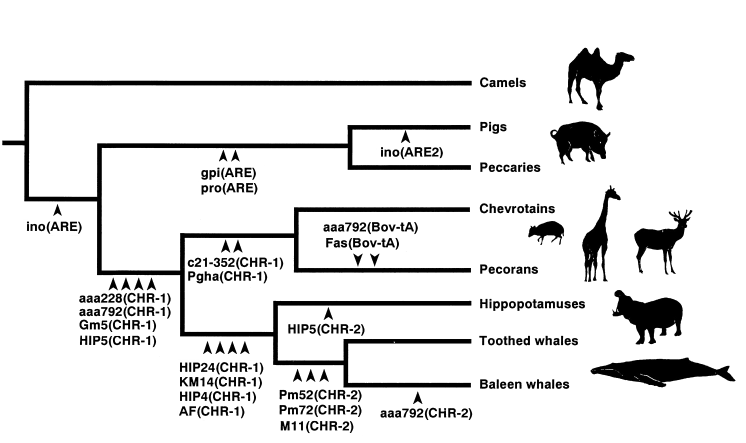Yeah, the genes of the creature.
The part where you expanded on your answer and demonstrated how it supports your thesis seems to have gotten lost in transmission. Do try again.
Speaking of genes, though, they show *clear* evidence of common ancestry -- the kind you claim can't exist.
For example, genes can accidentally acquire and then retain chunks of virus DNA during viral infections. These imbedded bits of crud from past infections are then passed on to descendants, like any other genetic material in the chromosomal DNA. Since they can occur almost anywhere in the enormously long DNA strand (their placement during viral infection is random), two animals which have exactly the same viral "crud" fragment (out of a huge number of possible fragment sections and sizes) in exactly the same spot in the DNA strand is *extremely* strong evidence that they inherited that crud from a common ancestor, since independently acquired DNA garbage would be unlikely to happen in exactly the same spot in exactly the same way -- unlikely to the order of many billions-to-one odds.
Now let's look at a map of some common viral "crud" (known technically as "endogenous retroviruses") shared among various species:

Oh, look -- 14 different endogenous retroviral sequences are found shared by various species in the primate family, *very strong* evidence of common ancestry. Even more interesting, the sequences which are shared (or not shared) by different species matches perfectly the "family tree" (i.e., which species split from which others in what order) indicated by the fossil record, morphological studies, and evolutionary predictions. Imagine that...
This sort of DNA support for evolution springs up EVERY time someone studies shared (or differing) DNA sequences among various species. Here's a similar map for various widely differing species of mammals:

And here's a different study which discovered the same results:

Here's the article for the above chart.
<< How does the fin know when to stop changing into a leg? Inquiring minds want to know. Evidently you do, so let's have it. >>
Fins don't evolve into legs.
They most certainly did. We have a pretty good stepwise sequence of fossils showing the transition from fins into legs:
Transition from primitive bony fish to amphibians
Few people realize that the fish-amphibian transition was not a transition from water to land. It was a transition from fins to feet that took place in the water. The very first amphibians seem to have developed legs and feet to scud around on the bottom in the water, as some modern fish do, not to walk on land (see Edwards, 1989). This aquatic-feet stage meant the fins didn't have to change very quickly, the weight-bearing limb musculature didn't have to be very well developed, and the axial musculature didn't have to change at all. Recently found fragmented fossils from the middle Upper Devonian, and new discoveries of late Upper Devonian feet (see below), support this idea of an "aquatic feet" stage. Eventually, of course, amphibians did move onto the land. This involved attaching the pelvis more firmly to the spine, and separating the shoulder from the skull. Lungs were not a problem, since lungs are an ancient fish trait and were present already.
- Paleoniscoids again (e.g. Cheirolepis) -- These ancient bony fish probably gave rise both to modern ray-finned fish (mentioned above), and also to the lobe-finned fish.
- Osteolepis (mid-Devonian) -- One of the earliest crossopterygian lobe-finned fishes, still sharing some characters with the lungfish (the other lobe-finned fishes). Had paired fins with a leg-like arrangement of major limb bones, capable of flexing at the "elbow", and had an early-amphibian-like skull and teeth.
- Eusthenopteron, Sterropterygion (mid-late Devonian) -- Early rhipidistian lobe-finned fish roughly intermediate between early crossopterygian fish and the earliest amphibians. Eusthenopteron is best known, from an unusually complete fossil first found in 1881. Skull very amphibian-like. Strong amphibian- like backbone. Fins very like early amphibian feet in the overall layout of the major bones, muscle attachments, and bone processes, with tetrapod-like tetrahedral humerus, and tetrapod-like elbow and knee joints. But there are no perceptible "toes", just a set of identical fin rays. Body & skull proportions rather fishlike.
- Panderichthys, Elpistostege (mid-late Devonian, about 370 Ma) -- These "panderichthyids" are very tetrapod-like lobe-finned fish. Unlike Eusthenopteron, these fish actually look like tetrapods in overall proportions (flattened bodies, dorsally placed orbits, frontal bones! in the skull, straight tails, etc.) and have remarkably foot-like fins.
- Fragmented limbs and teeth from the middle Late Devonian (about 370 Ma), possibly belonging to Obruchevichthys -- Discovered in 1991 in Scotland, these are the earliest known tetrapod remains. The humerus is mostly tetrapod-like but retains some fish features. The discoverer, Ahlberg (1991), said: "It [the humerus] is more tetrapod-like than any fish humerus, but lacks the characteristic early tetrapod 'L-shape'...this seems to be a primitive, fish-like character....although the tibia clearly belongs to a leg, the humerus differs enough from the early tetrapod pattern to make it uncertain whether the appendage carried digits or a fin. At first sight the combination of two such extremities in the same animal seems highly unlikely on functional grounds. If, however, tetrapod limbs evolved for aquatic rather than terrestrial locomotion, as recently suggested, such a morphology might be perfectly workable."
- Hynerpeton, Acanthostega, and Ichthyostega (late Devonian) -- A little later, the fin-to-foot transition was almost complete, and we have a set of early tetrapod fossils that clearly did have feet. The most complete are Ichthyostega, Acanthostega gunnari, and the newly described Hynerpeton bassetti (Daeschler et al., 1994). (There are also other genera known from more fragmentary fossils.) Hynerpeton is the earliest of these three genera (365 Ma), but is more advanced in some ways; the other two genera retained more fish- like characters longer than the Hynerpeton lineage did.
- Labyrinthodonts (eg Pholidogaster, Pteroplax) (late Dev./early Miss.) -- These larger amphibians still have some icthyostegid fish features, such as skull bone patterns, labyrinthine tooth dentine, presence & pattern of large palatal tusks, the fish skull hinge, pieces of gill structure between cheek & shoulder, and the vertebral structure. But they have lost several other fish features: the fin rays in the tail are gone, the vertebrae are stronger and interlocking, the nasal passage for air intake is well defined, etc.
More info on those first known Late Devonian amphibians: Acanthostega gunnari was very fish-like, and recently Coates & Clack (1991) found that it still had internal gills! They said: "Acanthostega seems to have retained fish-like internal gills and an open opercular chamber for use in aquatic respiration, implying that the earliest tetrapods were not fully terrestrial....Retention of fish-like internal gills by a Devonian tetrapod blurs the traditional distinction between tetrapods and fishes...this adds further support to the suggestion that unique tetrapod characters such as limbs with digits evolved first for use in water rather than for walking on land." Acanthostega also had a remarkably fish-like shoulder and forelimb. Ichthyostega was also very fishlike, retaining a fish-like finned tail, permanent lateral line system, and notochord. Neither of these two animals could have survived long on land.
Coates & Clack (1990) also recently found the first really well- preserved feet, from Acanthostega (front foot found) and Ichthyostega (hind foot found). (Hynerpeton's feet are unknown.) The feet were much more fin-like than anyone expected. It had been assumed that they had five toes on each foot, as do all modern tetrapods. This was a puzzle since the fins of lobe-finned fishes don't seem to be built on a five-toed plan. It turns out that Acanthostega's front foot had eight toes, and Ichthyostega's hind foot had seven toes, giving both feet the look of a short, stout flipper with many "toe rays" similar to fin rays. All you have to do to a lobe- fin to make it into a many-toed foot like this is curl it, wrapping the fin rays forward around the end of the limb. In fact, this is exactly how feet develop in larval amphibians, from a curled limb bud. (Also see Gould's essay on this subject, "Eight Little Piggies".) Said the discoverers (Coates & Clack, 1990): "The morphology of the limbs of Acanthostega and Ichthyostega suggest an aquatic mode of life, compatible with a recent assessment of the fish-tetrapod transition. The dorsoventrally compressed lower leg bones of Ichthyostega strongly resemble those of a cetacean [whale] pectoral flipper. A peculiar, poorly ossified mass lies anteriorly adjacent to the digits, and appears to be reinforcement for the leading edge of this paddle-like limb." Coates & Clack also found that Acanthostega's front foot couldn't bend forward at the elbow, and thus couldn't be brought into a weight-bearing position. In other words this "foot" still functioned as a horizontal fin. Ichthyostega's hind foot may have functioned this way too, though its front feet could take weight. Functionally, these two animals were not fully amphibian; they lived in an in-between fish/amphibian niche, with their feet still partly functioning as fins. Though they are probably not ancestral to later tetrapods, Acanthostega & Ichthyostega certainly show that the transition from fish to amphibian is feasible!
Hynerpeton, in contrast, probably did not have internal gills and already had a well-developed shoulder girdle; it could elevate and retract its forelimb strongly, and it had strong muscles that attached the shoulder to the rest of the body (Daeschler et al., 1994). Hynerpeton's discoverers think that since it had the strongest limbs earliest on, it may be the actual ancestor of all subsequent terrestrial tetrapods, while Acanthostega and Ichthyostega may have been a side branch that stayed happily in a mostly-aquatic niche.
In summary, the very first amphibians (presently known only from fragments) were probably almost totally aquatic, had both lungs and internal gills throughout life, and scudded around underwater with flipper-like, many-toed feet that didn't carry much weight. Different lineages of amphibians began to bend either the hind feet or front feet forward so that the feet carried weight. One line (Hynerpeton) bore weight on all four feet, developed strong limb girdles and muscles, and quickly became more terrestrial.
And if you're going to quibble about some of the details in the above, be sure to explain why no vertebrate had legs before the time of those fossils, then there arose amphibians with many fish-like features and primitive legs resembling the skeletal and muscular structure of the fish which existed shortly before... If the early amphibians didn't evolve from fish, God sure went out of his way to make it look as if they did.
You should have learned that when the coelecanth was rediscovered and what were thought to be transitional fin/legs turned out to still be 100% fins, supposedly 65 million years later.
What are you mumbling about here? No one ever claimed that the Coelacanth had legs. But fleshy lobed fins, like those in the Coelacanth, were an early stage on the way towards the development of legs.
Next you'll propose that sexual claspers on whales are vestigial legs.
Why would he want ot propose something false like that? Begone, straw man.